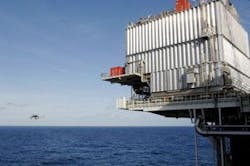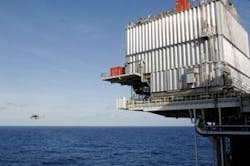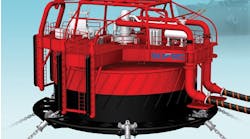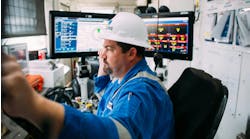DC link from Norwegian mainland powers Troll platforms
Nick Terdre
Contributing Editor
Statoil’s Troll A platform has become the first offshore installation to use high-voltage direct current (DC) power supplied from shore. Using technology developed by ABB, this feat establishes the viability of powering offshore operations from land, the benefits of which include the elimination of greenhouse gas emissions offshore. Similar projects are taking shape elsewhere in the Norwegian sector.
Troll, the largest offshore gas field in Europe, is the lynchpin of Norway’s gas supply to Continental Europe, supplying 15% of its needs. The field also plays a key role as a swing producer at a time when Norway’s gas exports are growing strongly. With some 200 bcm of its 1,300 bcm of reserves produced since the field came onstream in 1996, reservoir pressure has declined to the point where artificial help is required to maintain or increase production capacity.
This has been achieved through the $556-million Troll A pre-compression project, under which two compressor units were brought into operation early in October, lifting production capacity from 85 to 110 MMcm/d. Further compression capacity will be required as the reservoir pressure continues to decline, and Statoil expects to add two more compressor units during 2010-20.
Troll, which lies 67 km from shore, has a good record as an emissions-free platform, as it is already powered from land via a subsea cable supplying 20 MW of alternating current (AC) - the limit of what can be delivered in AC power at this distance.
Planning for compression began almost as soon as the platform came onstream. From an early stage, Statoil sought a power solution that was both economical and environmentally sustainable. With an 80-MW requirement to drive the two 40-MW compressors, replication of the existing power supply was not the answer.
But ABB was already developing new technology to deliver high-voltage DC power over long distances, and in 1997 the two companies started working together on applying this technology to Troll. By 2002, when Statoil awarded ABB contracts worth $250 million for the job, much of the preliminary engineering work had already been done. The solution consists primarily of two significant technology developments: HVDC Light and the very high voltage (VHV) Motorformer motor.
HVDC Light enables transmission of high levels of DC power over long distances without the need for heavy and space-consuming equipment at either the transmission or receiving end. For the Troll application, AC power at 132 kV is imported from the Norwegian grid at Kollsnes, the processing terminal for Troll gas. It is converted to DC power at 56 kV in a rectifier station and transmitted to the platform via four 40-MW subsea cables, two for each compressor drive.
The transmission cables are part of the HVDC Light technology. They are extruded polymer cables, which contain no oil. They are also compact: in the Troll case, the entire cable has a diameter of only 30 cm, including the 300 sq mm copper conductor, a layer of extruded lead to prevent water ingress and armoring to provide the necessary mechanical properties for installation on the seabed.
On the platform, the incoming DC power is transformed to AC power at 56 kV in an inverter station installed in the electric drive system (EDS) module, a 700-metric ton structure measuring 18 x 18 x 18 m. The AC power is fed to the electric drives for the compressor. These are Motorformer motors, the first in commercial application, which can be connected directly to a high-voltage power supply without the need for a step-down transformer. Shaft power of 55,000 hp is delivered to each compressor.
Both the EDS module and the two compressor skids, each weighing about 185 metric tons, were assembled at Haugesund yard, which was formerly owned by ABB, and installed on the platform in May 2004 by the Saipem crane bargeS7000.
The solution is an environmentally clean one; especially as the grid power is produced mainly from hydroelectric plants. By contrast, running the compressors with gas turbines or diesel engines installed on the platform would eventually have led to annual carbon dioxide emissions of 230,000 metric tons per year and 230 metric tons per year of nitrogen oxide. The CO2 emissions would also have been subject to tax.
The ABB technology compares well with onboard power generation in terms of weight and space requirements. And while gas turbines in an offshore setting often achieve an energy efficiency of only 20-25%, the HVDC Light system delivers power from grid to shaft with losses of just 7-8%.
ABB is now performing front-end engineering design for the converter stations for BP’s project to convert the Valhall field to run on power from shore. This application calls for 78 MW of power to be transmitted over 290 km. A further power-from-shore project is also under consideration by Statoil.
Under the Estlink project, which is due in operation in late 2006, ABB will provide a 350-MW, 150-kV transmission link over 85 km between Helsinki, Finland and Tallinn in Estonia, running for the most part beneath the Gulf of Finland.•




